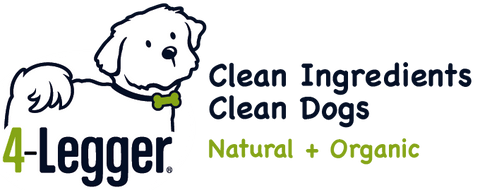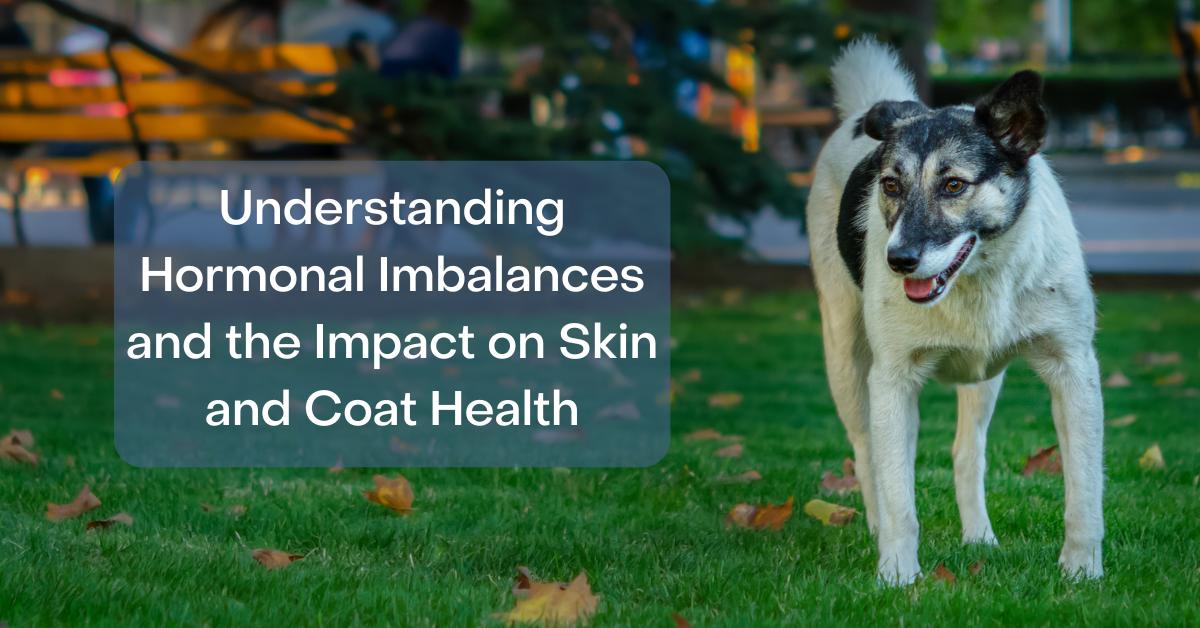Understanding Hormonal Imbalances in Dogs and How It Impacts Their Skin and Coat Health
Hormonal imbalances in dogs are more common than you might think and they can have a significant impact on your dog's overall health, particularly on their skin and coat.
According to the World Health Organization (WHO), endocrine disruptors (ED) are substances or mixtures that impair the functions of the endocrine system and cause harmful health effects on an intact organism or its descendants. Thus, exposure to ED can have lifelong effects, or even consequences for the next generation. EDs work by mimicking natural hormones, altering their metabolism or binding to their cellular receptors, thereby blocking endogenous hormone-receptor bonding. Their action covers all living organisms, whether human or animal, including aquatic fauna.
In this article we'll take a look at how to recognize a possible hormonal imbalance, the multiple factors that can impact your dog's hormone production and balance, and how hormonal imbalances impacts your dog's overall skin and coat health.
Recognizing the Signs of Hormonal Imbalance
We so often hear pet parents say that "all of a sudden my dog is scratching and miserable but I don't see any fleas."
Well... it wasn't really "all of a sudden", although it does feel like it.
The underlying issue has likely been caused by something that started years ago and the body finally reached a tipping point where the symptoms have started to show up on the skin and coat.
While a lot of things can cause itchy skin, many pet parents don't consider the root cause of the itchy skin being from a hormonal imbalance.
Signs of hormonal imbalance in dogs can vary but often include some of the following symptoms.
- Changes in your pet’s skin color or the consistency, thickness, or distribution of the coat.
- Increased licking, scratching, or chewing on their coat due to skin irritation.
- Clumps of fur found around the home. Your pet may lick, scratch, or chew their coat more often because of the irritation.
- Excessively dry or oilskin.
- Changes in appetite.
- Changes in weight.
- Changes in activity level.
- Joint pain.
- Increased vulnerability to skin infections.
What Can Cause Hormone Imbalances In Dogs
- Timing of Spaying or Neutering The top contributing factor to hormone imbalances is the timing of spaying or neutering. While these procedures are essential for pet population control, when dogs are spayed or neutered too early, before they reach full maturity, it can disrupt the natural balance of hormones in their bodies for the rest of their life. It isn't apparent at the time, but the imbalance in the hormones can have a long term impact on your dog's health as hormones play a critical role in various bodily functions, including the growth and maintenance of a healthy skin and coat. Estrogen and testosterone, in particular, have significant effects on the skin. They contribute to the thickness of the skin, the strength of the hair follicles, and the production of natural oils that keep the skin moisturized and the coat shiny. An imbalance, due to the lack of these hormones after early spaying/neutering, can lead to a range of skin and coat issues that likely won't show up until your dog is older. Dogs might experience thinner coats, slower hair growth, increased shedding, less oil on the skin and coat leading to dry skin, and even more serious conditions like atopic dermatitis or infections due to weakened skin barriers.
-
Exposure to Environmental Toxins
Several scientific studies (see below) have shown that environmental toxins, especially Endocrine Disrupting Chemicals (EDCs), can disrupt hormone balance. EDCs are substances that can interfere with hormone functions and are commonly found in pesticides, poor quality plastics, electronic waste, flame retardants, and even in products for dogs like shampoos and toys.
These chemicals can mimic natural hormones, alter hormone production or breakdown, affect hormone receptors, block hormone actions, or change how hormones bind. This disruption can lead to serious health issues such as developmental and reproductive problems, an increase in certain types of cancer, and changes in immune function.
Research also connects endocrine disrupting chemicals like bisphenol A (BPA), phthalates, dioxins, and polychlorinated biphenyls found in common household items, to metabolic problems such as insulin resistance and diabetes. This is based on extensive evidence from laboratory experiments, animal studies, and human data. For example, higher levels of dioxins in the blood are linked to greater chances of insulin resistance, and exposure to specific phthalates is associated with a higher risk of diabetes.
Moreover, environmental toxins can cause inflammation and oxidative stress, which are contributing factors in many diseases. EDCs increase oxidative stress and the production of cytokines, which are proteins that promote inflammation. These effects are associated with conditions like metabolic syndrome, diabetes, and obesity, highlighting the broad impact of these toxins on both hormonal and metabolic health.
Dog Shampoo Links to Hormone Imbalances
Even products advertised as “all natural dog shampoo” may contain ingredients that have links to hormone disruption. For example, many of the anti-fungal and anti-bacterial medicated dog shampoo products on the market contain chemicals that have links to hormone disruption.
- Amphoteric surfactants: Often advertised as "plant based cleanser" in many natural dog shampoo products.
- Benzyl benzoate: You likely won't see this ingredient listed on the ingredient panel of the dog shampoo as it is often found in artificial fragrances.
- Benzyl Salicylate: Associated with allergies and contact dermatitis as well as endocrine disruption.
- Cocamide MEA: A foam producer that started as a coconut and has been chemically altered into a moderate cancer causer, hormone and thyroid disruptor and an organ toxin. Another very common ingredient in dog shampoo advertised as all natural and organic (but it isn't).
- Dipropylene glycol: A type of alcohol that is used to improve the texture and stability of the formulation. Has concerns for endocrine disruption (low), non-reproductive organ system toxicity (low), and Irritation (skin, eyes, or lungs) (moderate). Can increase absorption of other chemicals through the skin and especially around the eyes.
- Ketoconazole: There is very strong evidence this fungicide, one of the most commonly used in medicated dog shampoo, is an endocrine system disruptor with limited evidence of reproductive toxicity.
- Methylparaben: A preservative linked to endocrine disruption.
- Paraben: Parabens are a class of preservatives or fragrances that are not planet friendly (ecotoxic) with strong ties to hormone (endocrine system) disruption.
- Propyl Paraben: A preservative that can mimic estrogen and likely act as a hormone system disruptor (endocrine system).
- Propanediol: Can increase skin absorption and has links to endocrine disruption and is known to cause skin irritation.
- Sodium Benzoate: Has links to allergies and there is limited evidence that it may have links to endocrine disruption.
- Tricolsan: An antibacterial with links to bioaccumulation, moderate non-reproductive organ system toxicity, skin irritation, endocrine disruption.
If you are worried about an ingredient and its safety in dog shampoo, look it up in the pet shampoo ingredient database. You can see if a chemical or ingredient is all natural, safe, able to be certified organic and any health risks associated with the chemical.
Natural Solutions for Healthier Skin and Coat
While no dog shampoo is going to reverse the long term effects of hormone disruption in the body, you can ease the symptoms of hormone disruption on your dog's skin and not cause any further endocrine system disruption by using a truly safe all natural dog shampoo.
The natural ingredients in 4-Legger organic dog shampoo can help soothe irritated skin and promote healing. Ingredients like aloe vera, coconut oil, and essential oils have natural anti-inflammatory, antimicrobial, and moisturizing properties, which can be particularly beneficial for dogs suffering from the effects of hormonal imbalances. 4-Legger natural dog shampoo is designed to provide a gentle yet effective clean, without the harsh chemicals found in many pet grooming products.
Integrating Natural Care into Your Dog's Routine
While early spaying/neutering can lead to hormonal imbalances that in time will affect a dog's skin and coat, understanding these risks and taking steps to mitigate them, such as spaying or neutering after your dog has reached maturity will help minimize negative hormonal effects.
Last June we adopted a new member to the 4-Legger pack. As a very young rescue dog she was spayed very early by the rescue organization. We add daily supplements for hormonal, glandular and adrenal support to her diet to help offset lurking imbalances that may negatively impact her quality of life as she gets older.
Avoid products that have links to hormone disruption such as the previously mentioned ingredients in traditional dog shampoo and use natural grooming products like 4-Legger natural dog shampoo which is certified through the USDA National Organic Program to ensure ingredient purity and product integrity. This simple change can help ensure your furry friend remains healthy and vibrant.
Combined with good habits like maintaining a species appropriate and balanced diet while incorporating regular exercise will go a long way ensure your pet remains healthy and happy for their whole life!
References:
Kutzler, M. A. (2020). Possible Relationship between Long-Term Adverse Health Effects of Gonad-Removing Surgical Sterilization and Luteinizing Hormone in Dogs. Animals: An Open Access Journal from MDPI, 10(4). https://doi.org/10.3390/ani10040599
Hart, B. L., Hart, L. A., Thigpen, A. P., & Willits, N. H. (2020). Assisting Decision-Making on Age of Neutering for 35 Breeds of Dogs: Associated Joint Disorders, Cancers, and Urinary Incontinence. Frontiers in Veterinary Science, 7. https://doi.org/10.3389/fvets.2020.00388
Hart, B. L., Hart, L. A., Thigpen, A. P., & Willits, N. H. (2014). Long-Term Health Effects of Neutering Dogs: Comparison of Labrador Retrievers with Golden Retrievers. PLoS ONE, 9(7), e102241. https://doi.org/10.1371/journal.pone.0102241
Hart, B. L., Hart, L. A., Thigpen, A. P., & Willits, N. H. (2016). Neutering of German Shepherd Dogs: associated joint disorders, cancers and urinary incontinence. Veterinary Medicine and Science, 2(3), 191–199. https://doi.org/10.1002/vms3.34
Torres de la Riva, G., Hart, B. L., Farver, T. B., Oberbauer, A. M., Messam, L. L. McV., Willits, N., & Hart, L. A. (2013). Neutering Dogs: Effects on Joint Disorders and Cancers in Golden Retrievers. PLoS ONE, 8(2), e55937. https://doi.org/10.1371/journal.pone.0055937
A. Barbaud1*; C. Lafforgue2 . Risks associated with cosmetic ingredients. Elsevier. 2021. https://hal.sorbonne-universite.fr/hal-03892132v1/document
Pocar P, Grieco V, Aidos L, Borromeo V. Endocrine-Disrupting Chemicals and Their Effects in Pet Dogs and Cats: An Overview. Animals (Basel). 2023 Jan 22;13(3):378. doi: 10.3390/ani13030378. PMID: 36766267; PMCID: PMC9913107.
Kimberly J. Wooten, Philip N. Smith. Canine toys and training devices as sources of exposure to phthalates and bisphenol A: Quantitation of chemicals in leachate and in vitro screening for endocrine activity. Chemosphere. Volume 93, Issue 10. 2013. Pages 2245-2253, ISSN 0045-6535. https://doi.org/10.1016/j.chemosphere.2013.07.075.





